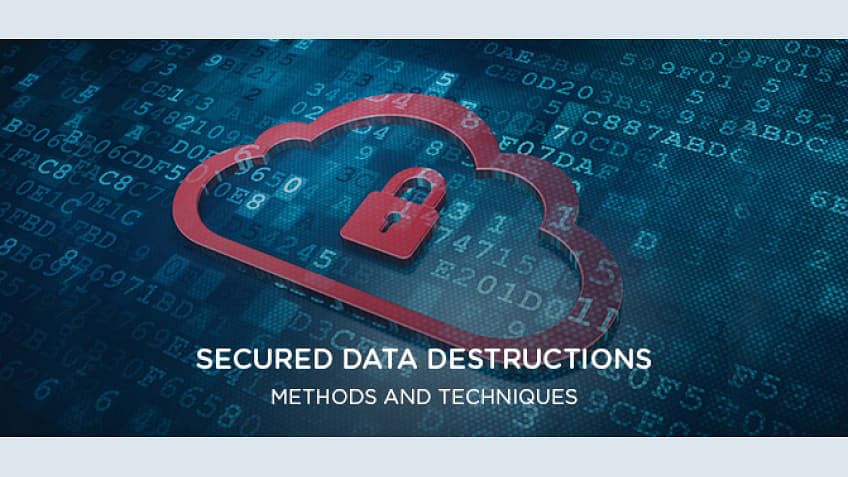Essential Cyber Security Practices for Effective Data Destruction Methods
Essential Cyber Security Practices for Effective Data Destruction Methods
Blog Article
Exploring the Importance of Information Devastation in the Context of Computer System Security Services and Protecting Confidential Data
In a period where information breaches are increasingly common, the relevance of effective data damage can not be overstated. Organizations must take on rigid procedures to make certain that delicate information is not just shielded throughout its lifecycle however also decisively removed when no more needed. The approaches used for data obliteration, combined with compliance to lawful criteria, play a pivotal duty in keeping confidentiality and depend on. Nevertheless, the implications of these practices prolong beyond plain compliance, affecting a business's reputation and functional integrity in the digital market. What approaches can companies execute to improve their data devastation methods?
Recognizing Information Destruction
Data damage is an essential component of computer system safety and security that entails the irreversible elimination of data from storage gadgets to avoid unapproved access and prospective data violations. In an increasingly electronic landscape, companies face heightened threats connected with sensitive details being incorrectly accessed or made use of. Effective information devastation safeguards against these hazards, ensuring that confidential dataâEUR" such as client details, intellectual property, and financial recordsâEUR" can not be recouped after disposal.
Comprehending the significance of information damage expands past mere conformity with regulative and lawful frameworks; it is crucial for keeping business honesty and trust. When information is improperly taken care of or inadequately damaged, the consequences can be serious, including economic loss, reputational damages, and lawful obligations.

Approaches of Information Elimination

One common technique is data cleaning, which entails overwriting existing information with arbitrary patterns several times. This method provides the original data irretrievable, making it a popular selection for organizations seeking to safeguard secret information.
Another method is degaussing, which uses a powerful electromagnetic field to interfere with the magnetic domains on storage devices, effectively removing the data. This strategy is particularly effective for magnetic media but is not applicable to solid-state drives.
Physical devastation is an additional durable method, entailing the shredding or crushing of storage space devices. This approach assurances that data recuperation is essentially difficult, making it suitable for highly delicate details.
Lastly, security can act as a corresponding approach to data removal. By encrypting data prior to deletion, organizations can include an extra layer of security, guaranteeing that also if remnants are recouped, they stay hard to reach without the decryption key. Each technique should be picked based on the level of information level of sensitivity and the details protection needs of the organization.
Legal Compliance and Data Safety
Organizations need to navigate a complex landscape of legal needs connected to data safety and security, specifically after executing techniques of information removal. Different regulations, such as the General Information Security Law (GDPR) and the Wellness Insurance Portability and Responsibility Act (HIPAA), enforce strict standards on exactly how organizations must dispose and manage of sensitive information. Failure to follow these guidelines can result in significant legal effects, consisting of considerable penalties and reputational damage.
Information damage procedures must be meticulously documented to demonstrate compliance with applicable regulations and standards. This documents not only acts as proof of adherence to legal responsibilities but additionally highlights a commitment to protecting delicate information. Organizations must additionally develop clear policies relating to data retention and devastation timelines, ensuring that information is not held longer than necessary.

In addition, normal audits and assessments of data damage techniques are necessary to preserve conformity and adapt to progressing legal frameworks (data destruction). By proactively resolving legal requirements, companies can alleviate dangers related to information violations and show their commitment to data security. Eventually, prioritizing lawful compliance in information devastation processes is not just a governing commitment, yet a basic element of a robust information safety and security method
Impact on Business Online Reputation
The track record of an organization can be substantially influenced by its approach to data destruction and administration. In today's digital landscape, where data breaches can happen anytime, the failing to properly throw away delicate info can result in severe repercussions. Organizations that improperly handle data damage risk exposing personal customer info, which not just breaches personal privacy legislations however also deteriorates trust fund amongst stakeholders and customers.
A ruined online reputation can lead to lowered client loyalty, as customers become reluctant to engage with an organization that has demonstrated oversight in protecting their data. Negative attention surrounding an information breach can have a lasting impact, as potential clients could be deterred by the viewed absence of safety and security. This can result in a direct decrease in earnings and market share.
Furthermore, services that prioritize information destruction as component of their safety and security technique can improve their credibility by showcasing their commitment to protecting delicate information. By taking on rigorous information monitoring pop over to this web-site techniques, organizations can not only alleviate dangers yet also place themselves as reliable entities in their respective sectors, therefore reinforcing their overall brand photo.

Best Practices for Secure Disposal
Executing finest practices for safe disposal of data is important for minimizing threats related to information violations and ensuring compliance with privacy policies. Organizations should embrace a comprehensive information disposal policy that lays out treatments for both physical and electronic data destruction.
For physical information storage devices, such as hard disk drives, navigate to these guys shredding or degaussing is recommended to stop information healing. Additionally, companies should maintain a chain of custody documents during the disposal procedure, ensuring accountability and traceability of disposed items.
For electronic data, utilizing software program that follows market requirements for information cleaning is vital. This software ought to overwrite existing information numerous times, making healing virtually difficult. It is additionally important to verify the effectiveness of the data devastation procedure with audits or third-party evaluations.
Training workers on protected disposal techniques adds an additional layer of safety and security, as human error can often bring about data exposure. Frequently assessing and updating disposal plans makes sure positioning with developing regulations and technical improvements. By carrying out these best methods, companies can significantly decrease the threat of unapproved data gain access to and boost their total information security technique.
Verdict
In verdict, data damage is a fundamental facet of computer safety and security services that guarantees the defense of private details from unapproved access. Applying efficient techniques of data elimination, sticking to lawful compliance, and acknowledging the effect on service credibility are necessary components of an extensive information safety and security strategy. By adopting ideal techniques for protected disposal, companies can foster depend on with clients and safeguard delicate data, eventually adding to a much more safe and find this secure electronic landscape.
In a period where data violations are significantly usual, the relevance of effective data destruction can not be overstated.Data damage is a crucial element of computer security that involves the long-term elimination of information from storage space tools to avoid unauthorized accessibility and prospective data violations. Organizations needs to likewise establish clear policies concerning information retention and damage timelines, making certain that data is not held longer than essential.
By proactively addressing legal demands, companies can minimize risks connected with data violations and show their commitment to data protection (data destruction). Ultimately, focusing on legal compliance in data damage processes is not just a regulatory responsibility, yet a basic aspect of a durable information protection technique
Report this page